Airspace Security – Nothing Escapes the German Air Force
Air Force- Reading time:
- 8 MIN


When an aircraft in German airspace cannot be contacted by radio, two Eurofighters take off and reconnoiter the situation, which could develop into what is known as a RENEGADE if terrorism is suspected. We explain the effort involved.
Two pilots run to their combat aircraft. They strap in and put on their helmets. Shortly afterwards two Eurofighters break clouds using their afterburners. They are after a passenger aircraft flying in German airspace without radio contact. After just a few minutes, the fighter pilots see the condensation trails of their target above the horizon.
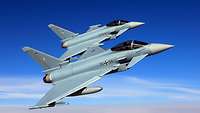
The Eurofighters of the QRAQuick Reaction Alert elements can be anywhere in German airspace within a few minutes.
German Air Force/Stefan PetersenThere is no radio contact anymore between the passenger aircraft and the civilian air traffic control agency on the ground. Using internationally standardized visual signals, the Eurofighter and passenger aircraft pilots now communicate with each other. That was lucky! The pilot of the civilian aircraft realizes what is wrong and corrects the mistake. It turned out that two digits had been swapped when entering the radio frequency. What a relief for the pilots and the personnel of the control agencies on the ground. The Eurofighters return to their base.
Even though the situation could be clarified quickly in this case, the process is highly complex. It is coordinated at the National Air Security Center near Uedem on the Lower Rhine. The National Air Security Center is an interagency establishment pooling the different responsibilities regarding German airspace security. This includes:
The National Air Security Center, which is Germany’s reaction to the attacks of 11 September 2001 and to the incident of a small aircraft circling Frankfurt in January 2003, has been in operation since July 2003.
The cooperation in this special establishment is based on the Act on Aviation Security as amended on 4 March 2017 and the common principles of the Federal Government and the Länder for cooperation as regards the prevention of threats to German airspace security posed by renegade aircraft. The legal requirements are derived from the Act on Aviation Security including the relevant court rulings.
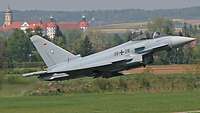
Afterburner takeoff of a Eurofighter of the Neuburg QRAQuick Reaction Alert element for a tango scramble.
German Air Force/Xaver HabermeierQRAQuick Reaction Alert (I) – Quick Reaction Alert (Interceptor) – the QRAQuick Reaction Alert Element In Germany, only the Air Force with its Eurofighter combat aircraft is capable of intercepting an aircraft flying at high altitude and at high speed. Two QRAQuick Reaction Alert elements are always on stand-by for airspace security in Germany: in the North in Wittmund and in the South in Neuburg an der Donau. Alternative air bases of the QRAQuick Reaction Alert elements are located in Nörvenich near Cologne and in Laage near Rostock. In principle, the QRAQuick Reaction Alert elements report to NATONorth Atlantic Treaty Organization (North Atlantic Treaty Organization). For national operations, command and control of the QRAQuick Reaction Alert elements is temporarily transferred to the National Air Security Center. |
In principle, the Federal Ministry of Transport and Digital Infrastructure is responsible for safe traffic management in the airspace over Germany. The ministry has issued an ordinance entrusting the DFS with the performance of sovereign air traffic control tasks. Air traffic control is a special police task and includes imposing entry and overflight interdictions as well as groundings. The DFS air traffic controllers work in front of countless monitors in five control centers in Germany and the Netherlands. They are in constant contact with the pilots of the aircraft and safely guide them on their flight through airspace. This is a mammoth task, given that the airspace over Germany is one of the busiest in the world. The airspace is divided into more than 80 sectors, and one or two controllers are responsible for air traffic in each sector.
When an aircraft crosses a sector boundary, the pilot receives the radio frequency for the next sector from the current controller. The pilot contacts the new controller on this frequency and continues the flight under the new controller’s control.
While this goes well countless times every day, it sometimes goes wrong. If radio contact with the new sector cannot be established, for example because two digits are swapped, the controller’s attempts to reach the aircraft will be futile. After five minutes at the latest, the watch supervisor of the control center concerned will transfer the task to the National Air Security Center if all means to establish contact from the ground have failed. The objective now is to reconnoiter the situation in the airspace.
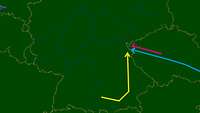
The Czech QRAQuick Reaction Alert (Quick Reaction Alert) element (pink) escorts the Indian aircraft (blue) to the border. At the border, the German QRAQuick Reaction Alert element (yellow) intercepts the passenger aircraft and monitors it.
German Air Force/CAOCAn Indian passenger aircraft was flying from India to London on its planned route. Over Romania, radio contact was lost. Shortly afterwards, the Hungarian QRAQuick Reaction Alert (Quick Reaction Alert) element was alerted by NATONorth Atlantic Treaty Organization (North Atlantic Treaty Organization) and scrambled. It reported that it could not see into the cockpit but that radio contact had been re-established. In this case, the NATONorth Atlantic Treaty Organization (North Atlantic Treaty Organization) Combined Air Operations Center (CAOCCombined Air Operations Centre) classified the situation as a suspected RENEGADE due to the prolonged loss of communication and the fact that it was not possible to see into the cockpit.
RENEGADE is the term used to describe cases in which there is a suspicion that a civilian aircraft may be misused for a terrorist attack or an otherwise motivated attack. The Indian aircraft remained on its planned course towards London the entire time. While the National Air Security Center was coordinating the preparation of measures for on-the-ground protection against threats, the QRAQuick Reaction Alert (Quick Reaction Alert) element monitored the situation in the air. The measures taken due to the declared suspected RENEGADE included a precautionary alarm to warn German nuclear power plants. As a result, the nuclear power plants took steps such as partial evacuation, which were based on the RENEGADE framework for nuclear power plants agreed between the Federal Ministry of the Interior and the Federal Ministry for the Environment, Nature Conservation and Nuclear Safety.
After the Indian passenger aircraft had left the German airspace, it was escorted by the Belgian QRAQuick Reaction Alert element in the Belgian airspace. The German QRAQuick Reaction Alert element returned to Neuburg an der Donau. A little later, the Air India aircraft landed as scheduled at London’s Heathrow Airport.
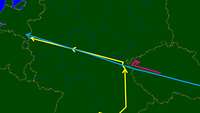
The aircraft is still suspected to be a renegade aircraft that is being misused for a terrorist attack. The German QRAQuick Reaction Alert (Quick Reaction Alert) element monitors the aircraft on its flight over Germany.
Bundeswehr/CAOC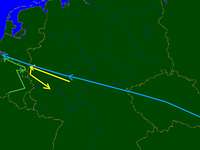
The Eurofighters turn at the German-Belgian border. The Belgian QRAQuick Reaction Alert element takes over. The national responsibility ends with the aircraft’s exit from German airspace.
German Air Force/CAOCAbout once or twice a month, a German QRAQuick Reaction Alert element takes off because there is no radio contact with a civilian aircraft. Such a case is referred to as a COMLOSS – the loss of all communication with the aircraft. As long as the situation remains a COMLOSS and does not aggravate, NATONorth Atlantic Treaty Organization (North Atlantic Treaty Organization) will usually remain responsible for carrying out the procedure. The operation in German airspace will also be monitored by the National Air Security Center.
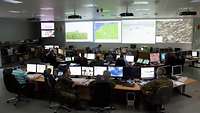
The staff at the National Air Security Center form a team that works well together and does not lose track of things even in critical situations.
German Air ForceIf, in a COMLOSS situation, it is also suspected that the civilian aircraft may be misused for a terrorist attack or an otherwise motivated attack (and is thus to be regarded as a RENEGADE aircraft), responsibility for the QRAQuick Reaction Alert element – which normally lies with NATONorth Atlantic Treaty Organization (North Atlantic Treaty Organization) – is temporarily transferred to Germany for this particular case. This act of national authorities taking over responsibility is referred to as Revoke Transfer of Authority (RTOA). The National Air Security Center will coordinate further measures and keep all relevant authorities in Germany continuously updated about the development until the end of the sorties.
All relevant information necessary for a detailed picture of the situation regarding German airspace security is captured at the working positions of the ministries involved in the National Air Security Center. For this purpose, personnel of the German Air Force, the Federal Police, the Federal Office of Civil Protection and Disaster Assistance, and of the DFS work hand in hand. Superior authorities and political decision-makers are provided with the situational information in the event of an incident. Thus, they obtain a basis for decisions on defense measures.
CRC - Control and Reporting Center For the estimate of the situation, it is important that the entire German airspace is monitored at all times. For this purpose, the Tactical Air Command and Control Service as part of the Air Mission Control Service of the German Air Force operates two control and reporting centers. The military personnel in those centers are tasked with identifying every aircraft over German territory within two minutes after detection and then continuing to track them. To do so, they use 18 military and more than 50 civilian radars and are in constant contact with the DFS. Closure on an aircraft that is to be identified – air interception – is carried out under the control of an interceptor controller at one of the CRCs. The interceptor controller subsequently forwards the reports of the pilots of the QRAQuick Reaction Alert element to the CRCs and forwards the orders of those centers to the QRAQuick Reaction Alert element. |
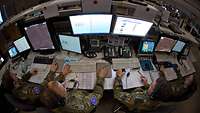
The men and women at the CRC are in constant contact with the pilots. On their monitors, they can see the location of the aircraft and all essential flight data.
German Air Force/Johannes HeynCAOCCombined Air Operations Centre - Combined Air Operation Centre In principle, the responsibility for military air surveillance lies with the CAOCCombined Air Operations Centre. In Europe, CAOCCombined Air Operations Centre Uedem is responsible for northern Europe, and CAOCCombined Air Operations Centre Torrejon (Spain) is responsible for southern Europe. Thus, the CAOCCombined Air Operations Centre also constitutes the NATONorth Atlantic Treaty Organization (North Atlantic Treaty Organization) field headquarters responsible for the sorties of the QRAQuick Reaction Alert elements. This means that the German QRAQuick Reaction Alert elements are among those reporting to CAOCCombined Air Operations Centre Uedem. Depending on how critical a situation is assessed to be, the CAOCCombined Air Operations Centre can place one or several QRAQuick Reaction Alert elements on heightened alert, or order their scramble straight away. In case of a suspected renegade in German airspace, responsibility is transferred to the National Air Security Center. The QRAQuick Reaction Alert element and the intercept controller responsible at the CRC will no longer receive their orders from the CAOCCombined Air Operations Centre but from the National Air Security Center. |